Read Part 1
I. Odd Photographic Evidence
Within the pages of his book, Mark Shaw incorporates several photographs and he offers explanatory comments pertaining to each. However, his analysis is erroneous and, therefore, his comments about the photo depictions is seriously flawed. Of course, he trotted out the now famous photograph of Marilyn flanked by John and Robert Kennedy following the 1962 event at Madison Square Garden. This photo was taken during the after-party at Arthur Krim’s Manhattan penthouse. Shaw publishes the cropped version of the photograph, the usual tactic of cheapjack writers. Invariably, the photograph has also been darkened, suggesting that the famous trio engaged in a secretive and a serious discussion of such import they did not want to be overheard, but Shaw’s commentary about the photograph soars to an unprecedented level of misrepresentation and distortion. After implying that Cecil Stoughton, the White House photographer, actually timed taking the photograph so that the full faces of John and Robert would be hidden from view, Shaw declared: “Within moments, JFK, by all credible accounts, asked Marilyn to step into the shadows where RFK stood, and the three of them spoke for more than ten minutes.” (Shaw, p. 397) Shaw did not divulge exactly who delivered the alleged “credible accounts” or who conscientiously timed the conversation. At any rate, the actual photograph reveals a much less sinister looking encounter between Marilyn and the middle Kennedy brothers. The left-hand photograph in the panel displayed below is the cropped version used by Shaw, but the right-hand photograph is the actual snapshot as taken by Stoughton.
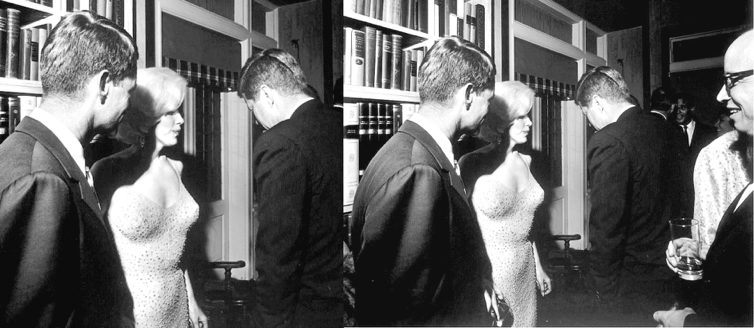
Obviously, the movie star and the politicians did not huddle alone in the shadows for ten minutes: they were, in fact, surrounded by many other guests who attended the Krims’ after-party. Another photograph taken at the after-party clearly indicated the number of people surrounding and touching Marilyn. Steven Smith, married to the Kennedy sister, Jean, and thus a Kennedy brother-in-law, wrapped his arm around Marilyn’s waist, displayed below on the left of the double panel; and many additional photographs indicated the crowded conditions as President Kennedy tried to converse with many of the Krim’s guests, including Jack Benny, displayed below on the right of the double panel. The bespectacled elder man in the background of the left-hand photograph was Marilyn’s escort for the evening, her former father-in-law, Isadore Miller.
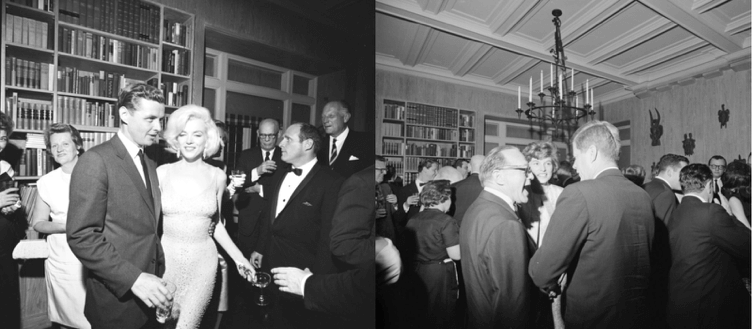
Isadore’s presence did not prevent Shaw from reporting yet another falsity about that historic event. He asserted that the Secret Service escorted President Kennedy and Marilyn from the Krims’ penthouse “to the Carlyle Hotel, where JFK maintained a penthouse.” Then Shaw quoted gossip columnist Earl Wilson, who later alleged, following Marilyn’s death: “It was the last prolonged encounter between them.” (p. 397) Neither Wilson nor Shaw recounted what actually happened following the Krim’s after party. They simply ignored it, disregarding the testimony of the persons actually involved in the events.
During the small morning hours, both Marilyn and Isadore Miller climbed aboard Marilyn’s rented limousine and headed to Brooklyn. She dutifully delivered her former father-in-law to his front door steps. According to Gary Vitacco-Robles, Marilyn implored Isadore to return to the west coast with her, when she returned to LA the following day; but he declined and replied: “Maybe in November.” (Kindle V.2:25) After a brief conversation, Isadore exited the limousine. Marilyn blew her former father-in-law a kiss and then she returned to her 57th Street apartment, where she exited the limousine, barefooted, her shoes in hand, and engaged in a brief curbside conversation with one of her ardent fans, James Haspiel. He testified on more than one occasion that Marilyn told him she was exhausted. “I can tell you with authority,” he later wrote in a publication about his association with her, “that I was with Marilyn at her apartment ten minutes to four in the morning. Categorically, Marilyn was not asleep at the Carlyle Hotel, and I didn’t notice the President anywhere nearby us.” (Vitacco-Robles, ibid)
After leaving her fan standing on the sidewalk, she proceeded upstairs to her apartment, where Ralph Roberts met her. Ralph testified repeatedly that he massaged Marilyn during that early morning until she fell asleep. Even so, Shaw asserts that Marilyn and the president had a “brief sexual encounter” after the Madison Square Garden celebration, simply not the case. Even J. Randy Taraborrelli admitted: His years of research and investigation clearly indicated that such an encounter did not occur. But, once again, the facts do not matter in the world of Marilyn apocrypha. And Mark Shaw is just getting started.
The exact location of Robert Kennedy during the 1962 weekend of Marilyn’s death, specifically on Saturday, August 4th, has been debated for decades. Where was the evil attorney general? Was he, along with his wife Ethel and four of his then seven offspring, in Gilroy, California, southeast of San Francisco, visiting John and Nancy Bates, their family and ranch? Or, was he in Brentwood visiting and murdering his rejected and distraught lover? Just where the hell was he? The answer: Robert Kennedy and a portion of his family were in Gilroy, California and according to 1.) John Bates, Sr., 2) his wife, Nancy, 3.) their eldest son, John Bates, Jr., and 4.) the ranch foreman, Roland Snyder, Robert Kennedy did not leave the ranch during Friday or Saturday.
Regarding the Attorney General’s location that weekend in August of 1962, Shaw equivocated. He wrote:
[…] there have been suspicions that the last person to see or hear from Marilyn may have been Robert Kennedy, and whomever may have joined him at her new home. While the accounts differ as to the exact time and duration of the potential visit, if true, RFK could have had a confrontational conversation with Marilyn regarding her going to the media and telling secrets threatening him and his family (p. 477, emphasis mine)
It is apparent that Shaw could not simply out-of-hand dismiss the Bates family’s testimony regarding that weekend and, even though he appeared to accept that Robert Kennedy visited Brentwood that Saturday, despite differing accounts regarding that visit, he also equivocated and employed phrases like “may have been.” But intent on having his cake and eating it, Shaw devises a truly bizarre tactic. Bear with me as it unfolds.
II. Wrong Car in the Wrong place
Early on Sunday morning, August 5th, after the group attended church in Gilroy, John Bates Sr. drove his visitors back to San Francisco and delivered them to the home of Paul Fay. The Kennedy family visited the Fays until the Attorney General delivered his speech to the American Bar Association on Monday, August 6th. Shaw publishes a Bates family photograph, displayed below. It depicts the Kennedy family just as they were starting to pile into the Bates family station wagon, preparing to leave Gilroy and the Bates Ranch.
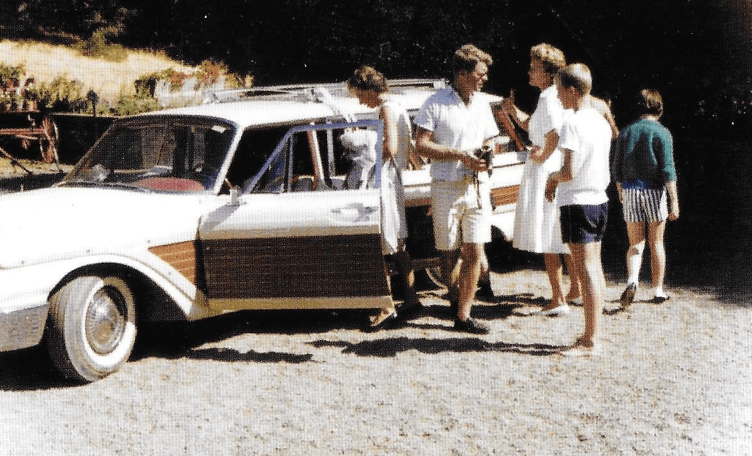
Mark Shaw holds that he obtained the Bates family photograph from Troy Vaughn, a former deputy sheriff and forensics expert from South Carolina, thus implying that the photograph had been kept hidden and was a deep and dark secret for nearly six decades until Shaw discovered it. This is a false implication. Susan Bernard, the daughter of the famous photographer Bruno Bernard of Hollywood, published not only the above photograph, but nine other photographs snapped by the Bates family during the Kennedy’s visit to their ranch that August weekend. Susan’s famous father not only photographed Marilyn on numerous occasions, he was also the movie star’s close friend. Susan included the Bates photographs in her 2011 photo journal, Marilyn: Intimate Exposures, which featured her father’s work with the movie star. Therefore, the photograph’s existence has been known for at least a decade, but, actually, much longer than that. Still, those facts did not interest Shaw. He called his reader’s attention to “the automobile with the driver’s side door open and the wood paneling beneath the window.” (p. 485) Was the paneling actually wood?’—but then, I digress.
Shaw now begins in earnest: after the photograph of the Bates’ station wagon, he publishes the photograph on the left, displayed below. Shaw failed to publish the photograph on the right, which also occurred on Sunday morning, August 5th.
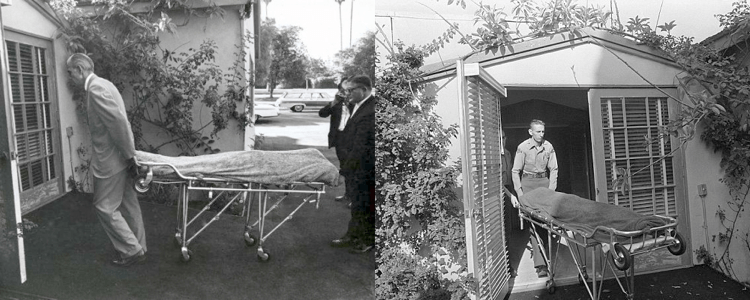
Shaw’s analysis of this tragic scene is a remarkable example of a literary mischaracterization. He writes that the photo “depicts two men, perhaps from the mortuary, wheeling Marilyn’s covered body not out of, for whatever reason, but into her home on the day she died.” Shaw then calls the reader’s attention to the station wagon pictured in the distance and adds that it “appears to be a duplicate of the car RFK and his family were standing by at the Bates ranch.” Shaw conceded, however, that the presence of the automobile might simply be coincidental. O really?! But he then speculated that “somehow the car was driven from Gilroy to Los Angeles and then appeared at Marilyn’s death scene.” He bemoaned the unfortunate reality that the individual who drove the car that eventful Saturday—which required a time investment of at least ten hours round trip—"will never be known.” For more information on Mark Shaw’s treatment of John Bates, Sr., read the sidebar, Mark Shaw Transformed John Bates, Sr. into Frank Ragano.
Mark Shaw Transforms John Bates into Frank Ragano
During WWII, John Bates, Sr. served in the United States Navy. While serving, the young sailor met and befriended the future President of the United States. Both Johns, Bates and Kennedy, became members of a San Franciscan host committee to assist with the formation of the United Nations. Although the senior Bates was a Republican, his character was such that, after America elected John Kennedy its 35th president, the new Commander in Chief invited his attorney friend to serve as an assistant to the Attorney General. The senior Bates declined: he was deeply committed to the prestigious law firm of Pillsbury Madison and Sutro. Still, Bates, Sr. remained friends with John and Robert Kennedy and the entire Kennedy clan.
The preceding small amount of biography leads to this: the exact location of Robert Kennedy during the 1962 weekend of Marilyn’s death. While there has been some pseudo-debate about the issue, on Saturday, August 4th, it has been well known that Robert Kennedy and a portion of his family were in Gilroy, California, visiting the John Bates family at their ranch. The Kennedy visit began on Friday afternoon, the 3rd of August, and ended on Sunday morning, August 5th. What I just stated is an established fact, but over the passing years, many conspiracist writers have questioned the validity of Robert Kennedy’s alibi along with the validity of the first-hand, eye-witness testimony provided by John Bates, Sr. and his wife, Nancy. My research into the lives of both John and his wife confirmed that they were exemplary individuals with impeccable reputations. I asked Donna Morel, herself a licensed California attorney, if she knew anything about attorney Bates. Only, she replied, that he had an outstanding reputation. Despite that stellar reputation, following the lead of his conspiracist brethren, Mark Shaw doubted the senior Bates’ honesty. The author based his doubt on a false allegation. According to Shaw, during the 1957 McClellan hearings, John Bates, Sr. represented the mobster, Sam Giancana. Thus, Shaw proclaimed:
Muddying the waters regarding RFK’s alibi on the 4th of August is the fact that John Bates served as an attorney for mobster Sam Giancana, RFK’s mortal enemy, during the same McClellan hearings where RFK served as chief counsel. That Bates covered up the truth as to Bobby’s whereabouts on the day Marilyn died would have certainly crossed the mind of Dorothy Kilgallen. (p. 484)
The McClellan Senate hearings included both Robert and his brother, then Senator John Kennedy. Robert was lead counsel, which Shaw correctly notes, but he failed to note the following: the interaction between RFK and various mobsters who testified—including Giancana—can best be described as acutely adversarial. In fact, Robert Kennedy ridiculed Giancana, needled him, referred to the dangerous mobster as a “little girl,” which must have humiliated the Mafioso. That being the case, if John Bates, Sr. was Giancana’s attorney, had allied himself with the Mob against his Kennedy friends, and in so doing, had betrayed them, this leads to an obvious question: Why would John Kennedy then immediately invite that attorney to join and serve in a Kennedy Administration, invite an unprincipled and untrustworthy Mob lawyer to work alongside his brother, the Attorney General? What illogical nonsense to even suggest that this is what transpired.
Again, with assistance from Donna Morel, I contacted John Bates, Jr. on July 26th via email and posed this question: was your father ever associated with Sam Giancana or the Mob in any capacity? He responded as follows:
Thank you for your inquiry. My father was a civil attorney. My father never practiced criminal law. At all times, he was exclusively a civil trial lawyer. His entire career was with the prestigious San Francisco law firm of Pillsbury, Madison, & Sutro, where he ultimately rose to managing partner. Never during his legal career did he appear before any legislative committee for anyone. He never represented a member of the Mob, organized crime, or Sam Giancana. Any assertions to the contrary are incorrect.
Mark Shaw failed to provide a source for his accusation about the senior Bates’ involvement with Sam Giancana. In his source notes for the chapter in which that accusation appeared—Chapter 32—Shaw vaguely referenced a 1985 New York Times interview with John Bates, Sr. During my research into the character of the senior Bates and the issue of Robert Kennedy’s location on August 4th, I located only one New York Times article involving John Bates, Sr. That article did not contain a single word about Sam Giancana or the senior Bates’ involvement with the mobster. Moreover, Mark Shaw did not provide any additional information or evidence to support his transformation of John Bates, Sr. into Frank Ragano, none whatsoever. Very odd, but also revealing. A reasonable person could only conclude that Mark Shaw did not know anything at all about John Bates, Sr. and he did not endeavor to learn anything about the respected attorney, either.
Still, Shaw covered himself and asserted that the Attorney General’s appearance in Brentwood at Marilyn’s hacienda was not the important issue. Oh, no? The important issue, what really mattered, was Bobby’s dumping rejection of Marilyn, just like JFK’s rejection, and if the second rejection by Bobby caused a confrontation and Marilyn’s threat to reveal their affairs publicly. Shaw then noted: “If he [Robert Kennedy] was truly in the San Francisco area, arguably the second most powerful man in America could have orchestrated her death with a telephone call from afar.” (p. 485) Interesting, is it not, even if Robert Kennedy was not in Brentwood, and even if he did not visit Marilyn that Saturday’—and he obviously was not and did not’—he still killed the world’s most famous actress with a lethal telephone call.
But what is really happening in the photograph that Shaw published, the one on the left in the two photo panel above? It depicts Pierce Brothers Cemetery and Mortuary employees wheeling Marilyn into that facility after her body had been delivered by Don and Guy Hockett; not into her house at Fifth Helena Drive. How can one do something like that by accident? Also, the photograph on the right side of the panel depicts coroner employees removing Marilyn’s body from the cemetery mortuary for its transportation to downtown Los Angeles for autopsy. Often, writers have erroneously asserted that the men in the snapshot are policemen.
Please return briefly to the first photograph of the Kennedy family preparing to leave the Bates ranch. You will note that the pictured station wagon had been equipped with a roof-mounted luggage rack. The distant station wagon in the left hand photograph above does not have a luggage rack. Also, since that photograph is black and white, we have no way of comparing the automobile’s colors and, too, please note the amount of open space, open land in the receding distance beyond the duplicate station wagon and also note the slender palm trees. Below is an aerial view of Marilyn’s cramped property with its kidney-shaped swimming pool, left side, combined with a photograph of Pierce Brothers Westwood Village Cemetery, right side.

III. More Wrong Depictions
Clearly, the photograph of the two men wheeling Marilyn’s body into the mortuary was not taken at Marilyn’s hacienda on Fifth Helena. It was taken at the Pierce Brother’s Westwood Village Cemetery and Mortuary, where Joe DiMaggio had Marilyn interred on August 8th. Additionally, Marilyn’s hacienda did not have French doors, a fact confirmed by the floor plan of the hacienda as it actually existed in 1962, displayed below.

Like most dutiful conspiracists, Shaw published the police photograph of Marilyn’s bedside table and, like his conspiracist compatriots, he published a cropped version, included below. Dutifully, he also noted that a drinking glass was not on Marilyn’s bedside table and one could not be found, neither in her bedroom nor her adjoining bathroom.
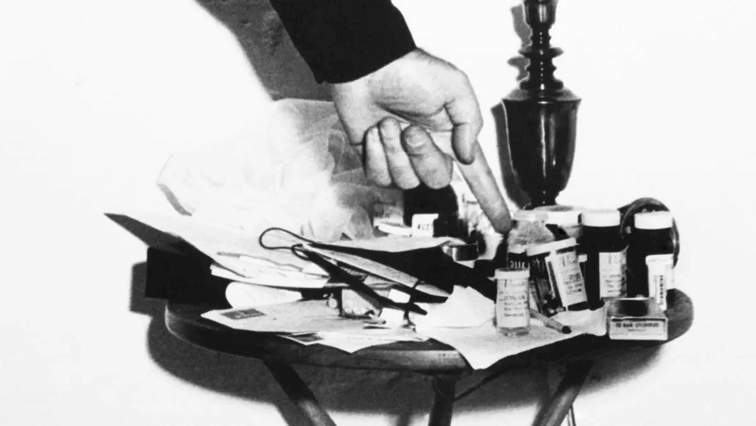
Displayed below is the actual, uncropped photograph taken that Sunday morning by police combined with an enlargement of the trash can area. Please note the drinking glass to the right of the trash can on the floor and to the left of Marilyn’s bed, a clearly visible drinking glass.
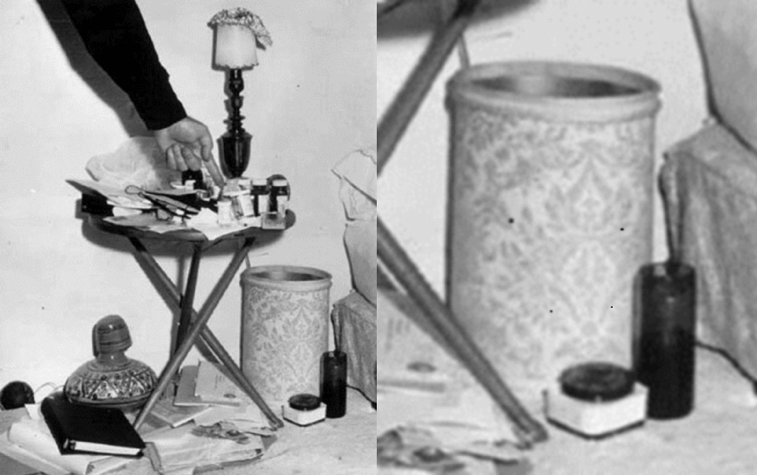
Following the photograph of the bedside table, Shaw published another police photograph of Marilyn’s bedroom, looking at her bedroom door, displayed below. While a policeman looked at the cluttered bedroom, beyond him was a woman with her back to the camera. Shaw labeled that woman as unidentified. In fact, a comparison of other photographs taken that morning would have confirmed her identity if Shaw actually did not recognize her: Eunice Murray, Marilyn’s housekeeper.
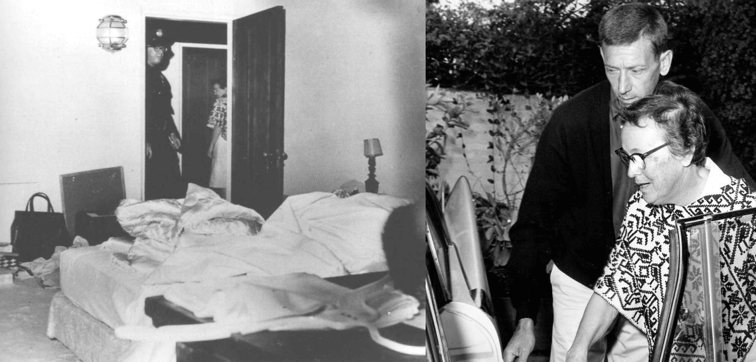
Regarding a related matter, Shaw included what he asserted was the bedroom wing layout of Marilyn’s hacienda and he paraphrased Eunice Murray’s testimony about that tragic Sunday morning: “while on the way to her bathroom,” Shaw noted, “she [Mrs. Murray] noticed light visible beneath Marilyn’s door, causing her to become suspicious that something could be wrong.” (p. 597) However, Shaw doubted that testimony, calling it inconsistent and apparently a lie. The layout of Marilyn’s home, he asserted, rendered her testimony unlikely or even impossible: Mrs. Murray had to leave her bedroom and walk into the hall in order to notice “a light under Marilyn’s bedroom door.” (p. 597) Displayed below is the drawing that Shaw used to confirm his assertion.
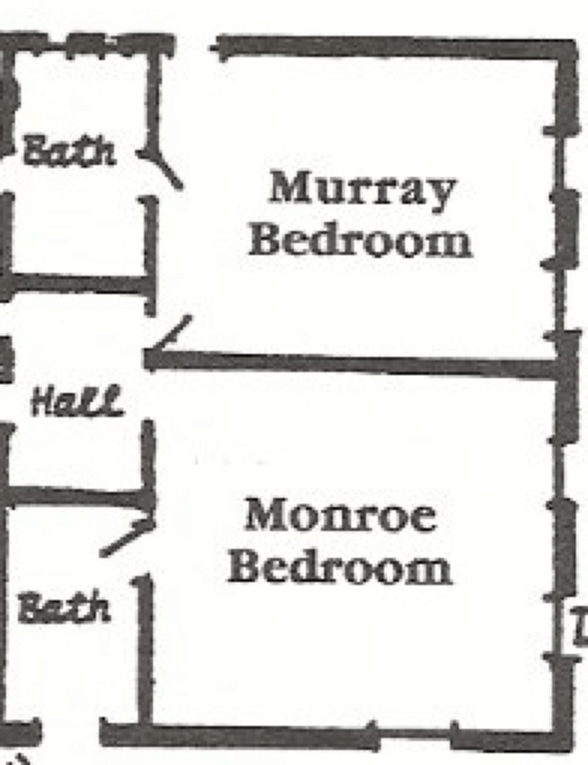
However, there is a major problem with that drawing: it is grossly inaccurate. Where are the clothes closets between the bedrooms, the linen closet, and where is the corner fireplace in Marilyn’s bedroom? Plus, the room denoted as “Murray Bedroom” was actually a bedroom Marilyn had reconfigured into her dressing room. Displayed below is the correct bedroom wing floor plan as it was in 1962.

On the night of August 4th, Eunice Murray slept in the smaller bedroom where Marilyn had positioned a cot, identified on the floor plan as “Guest Sleeping.” Pat Newcomb had slept in the same bedroom on the same cot when she spent Friday night with Marilyn. It is apparent that Mrs. Murray could have noticed light emanating from Marilyn’s bedroom on her way to the Jack and Jill bathroom and considering the arrangement of the bedroom’s doors, she could have stood at her bedroom door and easily observed Marilyn’s bedroom door. In the police photograph of Marilyn’s bedroom, looking across her disheveled bed at the opposing wall, clearly Mrs. Murray was preparing to enter the bedroom where she had slept, clearly visible from Marilyn’s bedroom door.
On page 515, Shaw published a photograph of Marilyn with her arm around the neck of a young fan, taken either preceding or following the premier of How to Marry a Millionaire on November 4th in 1953. Shaw identified that young man as Joe DiMaggio, Jr. Odd. Where is Joe DiMaggio, Sr.?’—an important consideration left unconsidered by Mark Shaw.
Born on October 23rd in 1941, the junior DiMaggio was twelve years old when How to Marry a Millionaire premiered in 1953 and, considering that his mother, Dorothy Arnold, took her ex-husband to court in an attempt to keep the youngster away from Marilyn’—Dorothy cited Marilyn’s unsavory vulgar character and her potential negative influence’—it is more than highly unlikely that Dorothy would have allowed her twelve-year-old son to attend a movie premiere with the disreputable movie star. Besides, the young fellow in the photograph published by Shaw appears to be at least 14 years-old and possibly even older.
The combined photographs below prove as much. To the left is the cropped version of Marilyn and her young fan as published by Shaw. To the right is a photograph of the junior Joe taken with the senior Joe at Ebbets Field on October 9th in 1953, approximately 30 days before the premiere of How to Marry a Millionaire. The lucky young man who received that hug from Marilyn was not Joe DiMaggio, Jr.
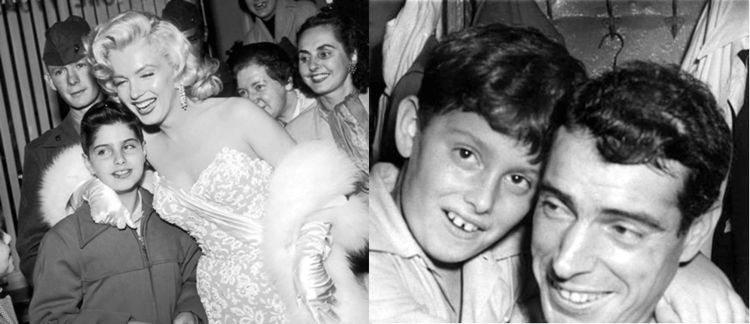
Finally, Shaw trotted out the famous thank-you note from Jean Kennedy Smith to Marilyn. During the Lawford’s 1962 February dinner party, Marilyn spoke to the ailing Kennedy clan patriarch via a telephone call instigated by Robert Kennedy. Joe Kennedy had suffered a serious stroke on December 19th in 1961, but he had yet to recover: he could barely speak. Robert must have felt that hearing Marilyn’s incredible voice would bolster the old man’s spirits. Sometime later, Marilyn sent a kind note to the senior Kennedy. In response to Marilyn’s kindness and her note, Jean Kennedy Smith wrote and sent Marilyn the aforementioned thank-you note. Both pages of the actual note follow.
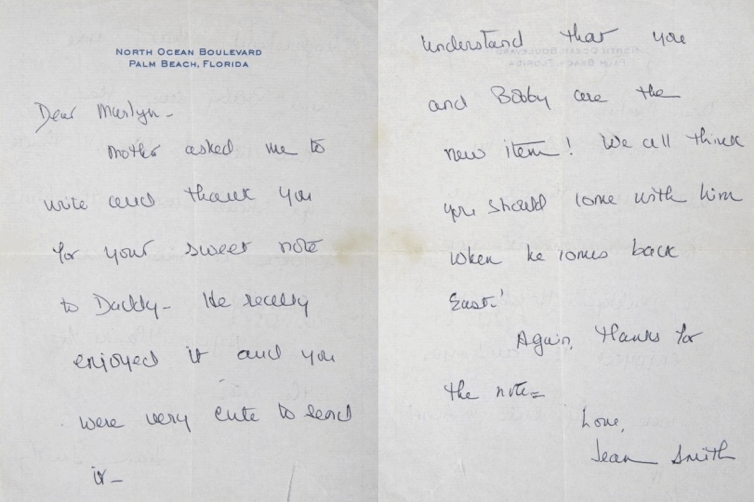
An innocent note, written and sent in response to a note that Marilyn sent to Joe Kennedy, Sr. It has always been of particular interest to conspiracists, including Shaw. But in his book, he published the note’s second page only, which begins with: “understand you and Bobby are the new item!” Clearly, Shaw did not publish the first page of the note for obvious reasons. Like conspiracists before him, Shaw breathlessly pointed to the thank-you note as evidence and proof that Marilyn and Robert Kennedy were involved in an affair and the invitation extended by Jean Smith for Marilyn to join Bobby when he returned to the east has been used by the conspiracists as evidence that Robert Kennedy’s extramarital relationship with Marilyn had been accepted by the Kennedy clan, specifically the Kennedy women. Should we assume, then, that both Ethel Kennedy and Jacqueline Kennedy had also accepted Bobby’s extramarital relationship with Marilyn?
Since Shaw ignored the first page of the thank you note, he was able to write the following ridiculous assertion: “Whatever Kennedy Smith knew’—whether from the mouth of her brother or through perhaps Peter Lawford, married to Pat Kennedy’—had triggered the letter.” (p. 572) As the first sentence of the thank-you note clearly stated, Rose Kennedy asked her daughter to write and thank Marilyn. That request “triggered the letter,” not something nefarious.
During the decades since the note was sent to Marilyn by Jean Smith, its context has been completely disregarded by the conspiracists, including Mark Shaw. Obviously, the comment about Marilyn and Bobby being “the new item” was meant as a tongue-in-cheek reference to Marilyn’s twist teaching efforts during the Lawford’s February dinner party and the uproarious scene caused by Robert Kennedy attempting to dance with Marilyn Monroe. Evidently, Ethel constantly teased the Attorney General over that humorous scene, as frequently noted by John Seigenthaler, Robert Kennedy’s friend and assistant.
That Jean Smith would invite Marilyn to visit Hyannisport seems only natural: who would not want Marilyn Monroe in their home for a visit? In point of fact, the lack of an invitation for Marilyn to visit would have appeared suspicious.
The conspiracist’s efforts to use that innocent note as proof of not only a romantic affair but the affair’s acceptance by the Kennedy clan and the Kennedy women is preposterous. That attempt should be viewed as manufactured since Sgt. Jack Clemmons, Frank Capell, Robert Slatzer, and Jeane Carmen were all complicit in it. For an author—who is also an attorney—to place himself in such a dubious crowd is: well, its mystifying.
IV: A Contrived Murder Scenario
Near the end of Collateral Damage, Mark Shaw revealed his hypothetical Marilyn murder scenario. But before I launch into my analysis of his hypothesis, let me briefly discuss what the Hollywood Godfather has asserted to be factual.
According to Gianni Russo, Robert Kennedy hired a Mob assassin to eliminate his rejected lover. “A guy known as The Doctor murdered Marilyn,” Russo testified to Michael Kaplan for a 3/2/19 New York Post article. The Doctor was a killer for hire and an actual MD who performed “major hits for the mob […].” This unnamed doctor “injected air into the vein near Marilyn’s pubic region,” which rendered the injection site invisible, Russo reported to Kaplan. Although Russo did not specify which vein or which part of Marilyn’s anatomy received the injection. How near is near?
In Russo’s aberrant world, Marilyn “died of an embolism, but it looked like drugs to the coroner,” just a garden variety overdose. I am not being the least bit facetious. While possibly the most inventive of Marilyn’s Murder Orthodoxies, Russo’s embolism tarradiddle is also certainly the most ludicrous. At any rate, I give him an A for Amagination and an F for Foolishness. How could a venous gas embolism create the lethal concentrations of Chloral hydrate and pentobarbital in Marilyn’s blood and liver? How could that air bubble deceive the tests performed by the head toxicologist and, further, trick him into interpreting the tests as indicating the presence of drugs, marking a massive overdose, when, in fact, the drugs did not even exist? That is, according to Gianni Russo. I assume every death from an embolism has been misdiagnosed as a drug overdose. Despite the ludicrous nature of Russo’s fairy tale, it has been reported by many newspapers, magazines, and Internet articles as the absolute truth. Yet, the most remarkable aspect of this curiosity is that Mark Shaw actually asserts that Russo’s incredibly imbecilic fairy tale has some credence. Once again, I am not being the least bit facetious.
An insane number of theories about the death of Marilyn Monroe have been developed and presented as fact during the past fifty-nine years: at least 12. The conspiracist authors who developed and presented those theories invariably contended that theirs was factual: the Last Word regarding the who, when, how, and why of Marilyn’s perceived mysterious death, her murder. Still, all of those theories did not satisfy Mark Shaw. Therefore, he developed one of his own. Let’s call his new theory Number 13. According to Shaw, Number 13 proceeds as follows.
Sometime near midnight, unable to sleep, Marilyn “heard a noise at her front door.” Upon opening the door, two gloved men assaulted her and “stunned” her by placing “a chloroform-sealed cloth over her nose and mouth.” Once stunned, the two men either dragged or carried Marilyn into her bedroom and, during that relocation, the men hit her lower body against a sturdy piece of furniture, or the open door’s edge or the doorknob. That inadvertent whack bruised Marilyn’s left hip. Once in her bedroom, the murderers removed any outer “clothing she was wearing such as a robe or panties” and they then carefully “positioned her nude body on the floor face down.” At this point, one of the men switched on the light and then locked the door, so they would not be disturbed. Water “secured from the bedroom faucet,” mixed with a lethal dose of both the Chloral hydrate and Nembutal became the ammunition for the murder weapon.
The murderers then “dipped a bulb syringe of some sort into” the drug mixture and then “inserted the tip into Marilyn’s rectum, with some spillage possible. Quickly, the lethal dose would have infiltrated her blood system and begun the march to her death.” Her murderers then placed Marilyn’s body face down on her bed and placed the telephone receiver “in her hand for effect.” After cleaning up “as best they could,” the two murderers “quietly left the home through the bedroom door,” which they locked on the way out. (pp. 612–613)
There are numerous problems with the preceding theoretical scenario. I’ll begin with time.
The alleged time that the murderers began the gruesome process of murdering Marilyn, midnight on August 4th, creates a serious issue for Shaw. According to Don and Guy Hockett—who collected Marilyn’s body at Fifth Helena and took her to the Pierce Brothers Mortuary, where she stayed briefly—her body was so rigid, they had trouble placing her on the gurney. They asserted, based on the degree of rigor mortis and the presence of fixed lividity, that Marilyn had passed on at about 10 PM. Natalie Trundy, later said that she and her fiancé Arthur Jacobs attended a concert that night. At approximately 11:00 PM, an usher arrived and informed Jacobs, then Marilyn’s publicist, that she was either nearly dead or already dead.
The temperature of Marilyn’s liver at 10:30 AM on August 5th, the time that Dr. Noguchi began her autopsy, as noted on her autopsy report, was 89°F, 9.6°F below what is considered normal. Virtually all the conspiracist writers have ignored that fact, including Shaw. According to the Glaister Equation, a formula used to calculate a person’s possible time of death, using a temperature differential from normal of 9.6°F, Marilyn could have died between the hours of 9:30 PM on the 4th of August and 2:30 AM on the 5th of August with a mean time of 12:30 AM on the 5th. Regardless of what time Marilyn’s essential bodily functions ceased (i.e. the exact time she actually died), it is evident that she became an unresponsive, comatose body at some point prior to 12:00 midnight: an essential detail. Therefore, Shaw’s murderers would not have encountered a conscious Marilyn near midnight on August 4th.
Consider the “chloroform-sealed cloth” that the murderers pressed against Marilyn’s nose and mouth. Did Shaw mean chloroform-soaked? At any rate, the use of chloroform to render a person unconscious is a myth started and perpetuated by Hollywood moviemakers. Evidently, the time required to knock-out a person using a chloroformed rag varies between five and ten minutes and, since liquid chloroform quickly evaporates into a gas when exposed to air, fresh liquid chloroform must be constantly added to the rag. Also, for the person to remain unconscious for an extended period of time, a freshly chloroformed rag must be held continually against the person’s nose and mouth. But then, Shaw alleged, that the chloroform “stunned” Marilyn. A stunned person would be groggy or dizzy, dazed. If Marilyn was only dazed by the chloroform, according to my research into the longevity of its effects, Marilyn would have regained her senses rather quickly: the effects of chloroform, in its gaseous state, diminish and disappear rapidly.
Shaw’s assertion that the murderers left the home “through the bedroom door” is an odd statement. As indicated by the floor plan of Marilyn’s hacienda, her bedroom did not have a door allowing access to the exterior. That is why Dr. Greenson had to enter Marilyn’s bedroom through one of the casement windows. I have concluded that Shaw’s assertion about the murderers’ getaway route is just another example of his many misstatements.
V. Shaw’s Bulb Syringe Murder Weapon
A major problem with Shaw’s contrived murder scenario resides in his vague description of how the assassins actually killed the movie star. They used a “bulb syringe of some sort,” which they dipped into a drug solution and then they inserted bulb syringe’s tip “into Marilyn’s rectum.” By bulb syringe, did Shaw mean the type of syringe often used to remove ear wax, irrigate sinuses, and remove mucous from the nostrils of infants? Certainly the killers drew a quantity of the drug solution into the bulb syringe, which they then injected into Marilyn’s rectum, but Shaw did not actually say that. Still, Marilyn could not have been killed with a normal size bulb syringe, one that could have dispensed two, maybe three ounces of the drug solution.
The largest bulb syringe I located could have dispensed twenty ounces, or 2½ cups, of the drug solution. But using a bulb syringe that large would have created its own set of problems. Shaw admitted that “some spillage” would have been possible, but certainly trying to infuse Marilyn’s rectum with 2½ cups of liquid using a large bulb syringe would have resulted in more than just some spillage. In fact, I contend, if she was unconscious, the spillage would have been considerable and would have stained Marilyn’s new white wool carpet.
More importantly, there are significant scientific problems with Shaw’s contrived murder scenario.
According to my research, while killing a person with an enema is possible, doing so is not that simple or easy. It requires an infusion of the descending colon with a large quantity of a lethal solution. It would be virtually impossible to murder a person by simply injecting a lethal solution into his or her rectum.
In Murder Orthodoxies, I wrote extensively about a similar situation, using the rectum as the route to murder Marilyn using a drug infused suppository. Chuck Giancana, Sam Giancana’s stepbrother, stated in his novel, Double Cross, that his stepbrother deployed suppository wielding assassins to murder Marilyn. Since killing with a bulb syringe would be similarly problematic, allow me to touch upon the significant points here. Keep in mind Shaw’s contention that the lethal solution “quickly infiltrated” Marilyn’s “blood system,” which led to her death.
The human rectum is primarily a storage chamber, a vertical section of the large intestine approximately 4½ inches long; therefore, it provides only about 50 square inches of an absorptive surface. Since the lining of the rectum is smooth, meaning devoid of the finger-like protrusions known as villi, absorption through it is neither efficient nor speedy. The International Journal of Pharmaceutical Sciences Review and Research noted that both the degree and the speed of drug absorption from the human rectum is both lower and slower than absorption from the gastrointestinal tract. It is highly unlikely, therefore, that the lethal solution proposed by Shaw quickly infiltrated Marilyn’s blood system. Additionally, blood circulation to and from the rectum is unusual. A list of various points follow.
- The inferior mesenteric and the internal iliac arteries supply the rectum with blood.
- The superior rectal vein, the middle rectal vein, and the inferior rectal vein along with anastomoses or venous plexus return blood from the rectum.
- The superior rectal vein connects to the portal system and directly to the liver, where it undergoes a degree of first pass metabolism.
- The inferior and middle rectal veins connect directly to the systemic circulation system, which delivers blood to the heart through the inferior vena cava and then throughout the body before reaching the liver.
- The anastomoses or venous plexus connect to both the portal and the systemic venous systems.
- The anal canal, which measures 1±½ inches in length, is the final part of the human digestive system and the inferior rectal artery delivers blood to the anal canal.
- The inferior rectal vein accepts blood from the anal canal and delivers it to the internal iliac vein and then to the systemic circulation.
Many studies have been performed to determine the bioavailability of drugs administered rectally. The percentages vary considerably with time and drug. A consensus does not exist regarding just how much of a rectally absorbed drug enters the portal venous system, gets delivered to the liver, where it is subjected to first pass metabolism, and just how much bypasses the liver on its initial trip through the body. Certainly, based on the anatomy of the rectum, which varies from person to person, as does each person’s physiology, the only reasonable position to assume, for the purpose of this discussion, is that 50% of an absorbed drug enters the portal venous system and then the liver, where a portion of it will be metabolized and 50% of an absorbed drug does not enter the liver on its initial trip through the body. Additionally, assuming that 50% of the absorbed drug passed through Marilyn’s liver initially and 50% did not, I suggest that more of the absorbed drug would have been found in Marilyn’s blood stream than is indicated. And that scientific fact leads me to this.
Shaw noted that the amount of chloral hydrate in Marilyn’s blood was 8.0 percent and the amount of pentobarbital in her liver was 13.0 percent, suggesting that the volume of blood in Marilyn’s body was 8% Chloral hydrate and 13% pentobarbital which, of course, was not the case at all. What Shaw actually meant was not a raw percentage but milligram percent or mg%, a measure of concentration; the mass of a chemical, given in milligrams, that is present in one-hundred milliliters of a solution, blood for instance. Also, Shaw failed to mention the concentration of pentobarbital in Marilyn’s blood, 4.5 mg%, quite a significant omission and a prime example of cherry picking in order to exclude relevant but unwanted evidence.
Abernathy’s tests indicated a concentration of pentobarbital in Marilyn’s liver three times as high as the concentration in her blood. Explained by a branch of pharmacology called pharmacokinetics, that relationship is consistent with ingesting a large overdose and proves beyond a reasonable doubt and to a scientific certainty that the drugs were ingested. The drugs were not injected into Marilyn’s body, she did not receive a hot shot, and she was not murdered with a bulb syringe, regardless of its size.
Finally, while Shaw’s hypothetical murderers killed the world’s most famous woman on that night, where was Eunice Murray? She does not appear in Shaw’s scenario, but we know she was in the house that night with Marilyn, asleep on a cot in the small bedroom very near Marilyn’s bedroom. Certainly, Mrs. Murray would have heard any noises caused by Marilyn’s struggle with the murderers. Once again, Shaw attempted to diminish his problem with Eunice Murray’s known presence that night. He opined:
Of course, as with any theory like this based on circumstantial evidence after so many years have passed, questions will be raised, with answers unfortunately somewhat speculative in nature. (p. 612)
Amazing. Shaw began to question his own theory, his own explanation of what happened to Marilyn and led to her death. What time did the killers arrive? he questioned. Where was Mrs. Murray when the killers arrived and enacted the gruesome scene in Marilyn’s bedroom? Shaw speculates that the murder possibly occurred between midnight and 3:00 AM, contradicting his proclamation that the murderers arrived “at some point close to midnight.” (p. 612) Then, regarding the bruise on Marilyn’s hip, Shaw admitted that “other explanations exist as to how Marilyn could have bruised her left hip.” (p. 612) However, if that bruise was caused as he speculated, then obviously foul play had been involved in Marilyn’s death. He then wondered if Mrs. Murray had “knowledge of the attempt on Marilyn’s life,” which he admits could not be known. (p. 615) He then speculates that Mrs. Murray became spooked by “hearing noise near Marilyn’s bedroom,” which caused “Murray to wonder if Marilyn was in distress” and prompted her “to call either Greenson or Engelberg.” (p. 615) Eventually, Shaw’s speculations centered on Dr. Greenson, Dr. Engelberg, and Eunice Murray and their possible complicity with Robert Kennedy who “orchestrated Marilyn’s death via operatives sent to her home.” (p. 617) Frankly, it became self-evident as I read Shaw’s speculations and strange contradictions, that he likely did not even believe Number 13, which he himself formulated. So why should I? Besides, I know Shaw’s Number 13 is a fantasy founded on sensationalism. Marilyn was dead before midnight. Evidence, not speculation, confirms that and confirms that Marilyn certainly was not alive at 3:00 AM on August 5th. Unlike Mark Shaw, rigor mortis and fixed lividity do not speculate.
VI: A Brief Summation
Before ending with a brief summary, I would be remiss if I did not note the following. During a recent interview with Heather McDonald, Mark Shaw asserted that he wrote Collateral Damage because he “never bought the idea that Marilyn committed suicide.” The author then added: “When I heard about it I didn’t believe it and I still don’t and I’ve proven in the new book that it didn’t happen.” Shaw proceeded to add: “In this particular book I did not use any sources with books or anything else from 1965 on. They [Shaw’s sources] were all before sixty-five.”
Remarkable. Shaw brazenly admitted that he began writing with an occluded mind based on a foregone conclusion. Most certainly, as he wrote, he was afflicted with an idée fixe and a form of group think, leading him to engage in cherry picking, confirmation bias, belief perseverance, illusory correlation, and fallacious reasoning.
Why would an author in search of the facts, in search of the truth, deny the validity of all the valuable research into Marilyn’s life and her relationships after 1965, not only with the middle Kennedy brothers, but her other relationships as well? Why would he deny all of the valuable research into the circumstances surrounding her death that has transpired during the past 59 years? Why would he limit his source material to only the 3 years following her tragic death? And finally, why would he evoke discredited men like Frank Capell, Sgt. Jack Clemmons, and many others, including both C. David Heymann and the incorrigible fabulist, Gianni Russo, who did not appear with his Marilyn fantasy until 2005 and his book was not published until 2019—both dates decades beyond 1965. Using Russo as a source is a contradictory reversal of Shaw’s source edict and why would Shaw present those men as reliable sources? The answer is obvious: Shaw wanted and needed sources that confirmed his foregone conclusion, not unlike every conspiracist author who has written about Marilyn Monroe’s life and her death.
Shaw calls Senator Joe McCarthy a despicable man whose heart was filled with hate. But the author himself engages in a despicable form of McCarthyism, because of the apparent hatred in his heart for Robert Kennedy. Referencing the Chappaquiddick tragedy, Shaw asserted that Teddy Kennedy’s conduct, how he handled the drowning of Mary Jo Kopechne “was symbolic of the selfish ‘me first’ mentality of the Kennedys, especially RFK.” (p. 558) Robert Kennedy was already killed at that time. Even so, guilt by familial association is Shaw’s assessment. Robert was even more selfish and uncaring than the youngest Kennedy brother.
Within the text of Collateral Damage, Mark Shaw devoted many words and pages to the exceptional investigative prowess of Dorothy Kilgallen, who constantly searched for the facts in every significant story or case, searched for the truth and justice. Based on comments within her published articles, Shaw asserted, Dorothy suspected that her “friend” did not commit suicide, suspected that her friend was romantically involved with Robert Kennedy, and suspected that her friend’s death involved the attorney general. Shaw knew without debate, all the unsolved mysteries surrounding and all the unanswered questions left in the wake of Marilyn’s mysterious death would have been solved and answered after an investigation by the incredible Dorothy Kilgallen. Since Marilyn died in early August of 1962, what prevented Dorothy from focusing her investigative spotlights and powers on her “friend’s” mysterious death? Of course, 16 months after Marilyn’s death, Dorothy became embroiled in the president’s assassination, the murder of Oswald, and then the sensational trial of Jack Ruby, but she had at least 16 months during which she could have investigated Marilyn’s suspected murder. Again, what prevented her?
Shaw must have realized that the absence of any investigation by Dorothy Kilgallen was a problem for him, so he proffered an explanation. During the October missile crisis, with humanity on the precipice of nuclear war, possibly annihilation, “in perhaps his finest hour, RFK stood tall and helped his brother quell the threat.” Dorothy Kilgallen, Shaw presumed, because of her integrity—and the fact that Robert Kennedy had helped save humanity—“could not in good conscience go forward, and this stifled any further probe involving RFK.” (p. 600) According to Shaw, Dorothy Kilgallen’s integrity actually prevented her from exposing the murderer of her “friend,” the most famous actress in the world. Truly amazing conjecture based on absolutely nothing. There was no credible evidence Robert Kennedy and Marilyn were ever romantically involved, less that he was part of her murder.
In fact, Dorothy Kilgallen’s columns following Marilyn’s death had been based on rumor and gossip, innuendo and sensationalism. All advanced by other luminaries in the gossip mongering field: Walter Winchell, Earl Wilson, Louella Parsons, and James Bacon. As of right now in America, rumor, gossip, and innuendo do not qualify as evidence.
Still, Shaw promised his readers that he would reveal new and compelling evidence regarding Marilyn’s death. He didn’t. He merely recited, right on cue, what Sarah Churchwell accurately identified as the same tales and bromides.
For example, he resurrected the CIA-UFO-Memo as evidence that Marilyn was possibly murdered, because she knew about the existence of little green men. Shaw insinuated that the memorandum was new evidence, when it was, in fact, inordinately old news.
Twenty-six years ago in 1995, Milo Speriglio introduced the memorandum to the world during a press conference and, since that time, the document has been evaluated and analyzed innumerable times. Nick Redfern just published a book that yet again evaluated that dubious memorandum. Many UFOlogists and impresarios in the odd world of flying silver discs generally agree on this: that document is a hoax, a crafty forgery.
Shaw, however, interjected a new wrinkle: he asserted that the one of the telephone conversations mentioned in the memorandum occurred between Dorothy Kilgallen and Marilyn who “told Kilgallen that JFK had told her of his visit to a secret air base where he viewed ‘things’ from outer space.” (p. 386) I have read that memorandum at least two dozen times and it does not state that Marilyn revealed to Dorothy Kilgallen anything heard from the lips of or otherwise learned from President Kennedy. Clearly, according to the memorandum, Howard Rothberg imparted hearsay evidence to Dorothy involving some secrets Marilyn allegedly knew, one of which involved the president, a secret air base, and things from outer space. Still, regardless of what the CIA-UFO-Memo alleged, I repeat, that document is now recognized to be a forgery.
In 2006, on the CBS program, 48 Hours, Peter Van Sant and Anthony Summers presented and generally discussed an FBI file that Mark Shaw also resurrected. Sent from Mexico City and dated the 13th of July in 1962, number 105-40698-3, the file referenced a
luncheon at the Peter Lawfords with President Kennedy just a few days previously. She [Marilyn] was very pleased, as she asked the President a lot of socially significant questions concerning the morality of atomic testing and the future of the youth of America.
According to my research and according to the John F. Kennedy Presidential Library and Museum along with the website, History’s Home on the Web, President Kennedy was either in the nation’s capital, Camp David, or Hyannis Port throughout the month of July in 1962, except when he delivered a 4th of July speech at Independence Hall in Philadelphia. Even though, during that CBS program, Summers presented the now 59-year-old FBI document as being factual, 21 years earlier, Summers admitted in his pathography, Goddess, that his investigation regarding that alleged meeting revealed “no day in the relevant time-frame when John Kennedy could have been in Los Angeles’—he made an official visit to Mexico at the end of June.” (Summers, p. 577) Obviously and evidently, President Kennedy did not travel to California in July of 1962, which leads to an obvious conclusion: President Kennedy did not meet Marilyn at the Lawford’s beach house for a luncheon.
But then, throughout Collateral Damage, Mark Shaw followed along the well-worn path created by the footfall of an almost endless parade of conspiracists who have preceded him. He, like they, promised his readers he would prove with new and compelling evidence that Marilyn Monroe did not commit suicide. Yet, he merely engaged in not only rumor, opinion, gossip, and innuendo; he also engaged in the worst form of gross speculation and evidence creation. While presenting testimony lacking any evidentiary value whatsoever, he also presented testimony from two sources whose verity has been questioned repeatedly and from one source whose testimony has obviously been manufactured. Additionally, he otherwise twisted the facts to fit his foregone conclusion: Marilyn Monroe was murdered, not only murdered, but murdered by Robert Kennedy.
Oddly though, Shaw asserted as his text approached its conclusion: “it appears that Marilyn Monroe had been right, as noted, when she wrote in My Story, ‘Yes, there was something special about me, and I knew what it was. I was the kind of girl they found dead in a hall bedroom with an empty bottle of sleeping pills in her hand.’” (p. 600) Did Mark Shaw fail to realize that Marilyn was referring to her death by overdose, her death by suicide?
If Mark Shaw really wanted justice for Marilyn, which, considering his use of Gianni Russo, I doubt, then Shaw would have let her rest in peace. But evidently that would be an empathetic compassion beyond a conspiracist’s comprehension.
Addendum
The other material about Dorothy Kilgallen and JFK in Shaw’s book is largely repetitive of his earlier works. Since it is such, we refer the reader to Jim DiEugenio’s reviews of The Reporter Who Knew Too Much and Denial of Justice.
